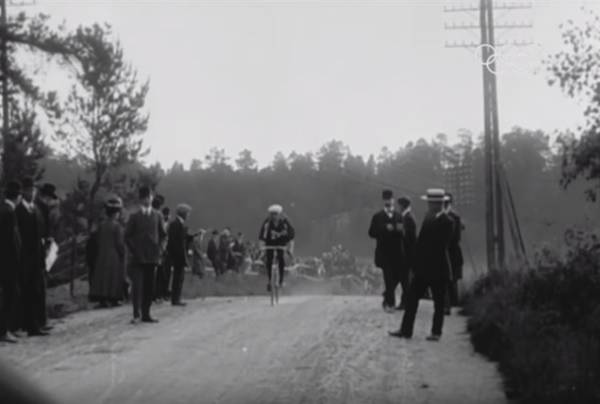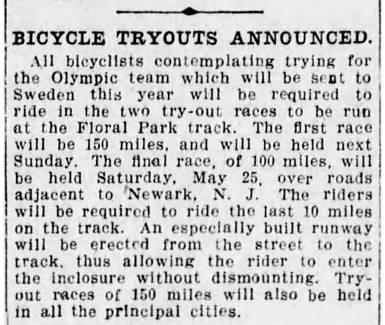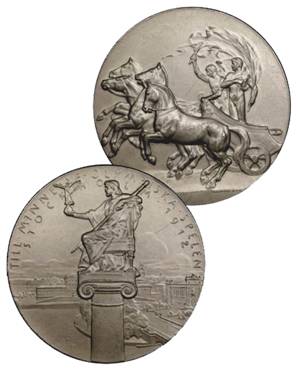Making the Team
The modern Olympics had been instituted in 1896, and as late as 1909, a number of nations still were uncertain about continuing with them. The most recent Olympiads had experienced problems: spotty participation in St. Louis in 1904, hasty relocation of the 1908 games (from Rome to London, thanks to the financial impact of the 1906 eruption of Vesuvius), and an overall tendency toward un-Olympic commercialism.
For the 1912 Olympics, a consensus was reached that Stockholm would be the only bidder for the Vth Olympiad, based on its commitment to the perceived principles of the ancient games. In keeping with that commitment, Swedish authorities revisited the list of sports which would be contested, and they decided to exclude cycling. In fact, to make room for other sports venues, they demolished Stockholm's only velodrome. Their decision was met with international opposition in favor of cycling (including one proposal for bicycle polo).
A compromise was reached: there would be one cycling event at Stockholm - a road race, for which individual and national team medals would be awarded. An existing cycling route near Stockholm would be used; local races had been held on it for several years. It was daunting, wrapping around Lake Mälaren on dirt roads, some of them likely to have ruts from automobile traffic. There were hills, some described in the press as "mountainous." Moreover the course was long, measuring not quite 199 miles. It remains the longest course ever used for any type of race in the modern Olympics.
|
|
In the spring of 1912, newspapers around the country carried notices similar to this one. Clearly, endurance was in order. Cyclists who only sprinted, or those who depended on their quick lane changes on velodrome tracks, need not have bothered to attempt the long road races.
|
And so, on the 5th of May, Pete Steinert and 21 other cyclists (some news reports miscounted them) assembled at Floral Park to pedal for 150 miles. There would be three laps. Maps of the precise route do not seem to have survived, but this much is known: from Floral Park, riders raced to Amityville, then went north, passing through Hicksville to Jericho, and then they returned through the same towns to Floral Park to conclude a lap of 50 miles. I do not know if the return trip followed precisely the same roads as the outbound. I also do not know what accommodation was made for the railroad crossings along the way - it is doubtful that the Long Island Railroad would have stopped its trains so that cyclists could cross the tracks ahead of them.
Only ten of the starters finished the race, and the top competitors among them were excellent:

Within a week, seven comparable races had been completed across the country. A news report stated that the top finishers from all eight races would compete against each other on May 24th in a final qualification race, in order to determine the members of the Olympic cycling team. That report was not exactly correct, however....
Well before the final qualifying race, newspapers announced that Pete Steinert had been named to the Olympic cycling team. Apparently, similar news reports appeared around the country for other competitors. For the final qualification race, only twelve competitors assembled at Newark; Steinert was not among them. They raced one mile (six laps) around the track, then continued into Newark and raced 98 miles through New Jersey, returning to the velodrome for the 100th mile. Based on the results of this race, and performances in earlier races, the final roster of the team was named, including alternates to replace any riders who for some reason could not compete in Stockholm.
With their departure for Europe a few weeks away, the athletes had to stay in shape, and the team needed to raise money. Hence, early in June, some of the U.S. Olympians participated in a fund-raising day at Celtic Park(a sports complex in Queens, built by the Greater New York Irish Athletic Association; it was adjacent to Calvary Cemetery). There were track and field events, and also an East-West bicycle race, with Steinert (who, thanks to his mother Agnes, was half Irish) competing for the East.

wingedfist.org/Celtic_Park_History.html
Two days before the athletes departed for the Olympics, the Hicksville A.C. honored Steinert, at a dinner at Hicksville's Wolgast Hotel. Among the several speakers was his father, the venerable Judge. Pete was presented with an inscribed silver cup, in honor of both the work he had done for the club, and his representing his country in the upcoming games. Some of those present posed for a group photo, which later was published in the Long Islander newspaper (shown below, with annotations added). Steinert, his bicycle, his father, and three of his six brothers appear in the image.

Note that the Long Islander labels the man seated to the left of the bicycle as "James Jr." He is either James Steinert, or he is Joseph Steinert Jr.
The opening ceremonies for the 1912 Olympics began late on the morning of July 6th, each nation's athletes following their country's flag as they marched into the stadium. With the entrance of the Japanese team, the games became the first Olympics to include competitors from five continents. King Gustav V spoke; he would continue to participate in ceremonies during the games, personally awarding medals to athletes.

Athletes Entering (the U.S. Team is wearing dark blazers) / olympic.org/stockholm-1912
The cycling race was to be contested the next day. The determination of the team medals would be straightforward: the times of each nation's top four finishers would determine the rankings. With regard to the official log of the participants, any rider who crossed the finish line with a time more than 25% above that of the winner would be deemed to have not finished the race. The cyclists had been assigned to groups for the staggered start, with each group departing at a fixed time. As the first group was to start at 2:00 AM, it is doubtful that many cyclists lingered at the conclusion of the opening ceremonies.
Some motion picture footage of the race survives. The screen shot below was taken from https://www.youtube.com/watch?v=f7c7Nka_LHE It includes about a minute of film clips.

olympic.org
120 cyclists started the race. Rudolph Lewis, a South African, was the individual winner, having completed the course in 10:42:39, with an average speed over 199 miles of more than 18.5 mph. American Carl Otto Schutte of Kansas City was third at 10:52:87. Pete Steinert finished at 12:08:13, well behind, but still among the top half of the starters. The team winner was Sweden, with a four-man total time of 44:35:34 (the top four Swedish riders, very familiar with the course, consecutively finished seventh through tenth). As in the individual rankings, Great Britain was second in the team rankings, and the U.S. was third, with its top four riders totaling 44:47:55, exactly 42 minutes ahead of the next team's total.
From an American perspective, Schutte was the cycling story of the games. In the 150 mile qualifier in the heat of St. Louis, his winning time against a handful of opponents had been an unspectacular 10:42:05, nearly the same time it took him to ride 49 miles further in Stockholm. In the final qualifying race in Newark, his pace had been much more impressive, but doubts had lingered about his endurance beyond 100 miles.
|
Pete Steinert, and the other American cyclists who finished below the top four, must have felt some disappointment. Nonetheless, their hours spent pedaling over 199 miles of unfamiliar terrain had demonstrated that they ranked in the upper echelon of the world's best. Indeed, even using the average speed of the top eight Americans instead of only the fastest four, the U.S. still would have won the team bronze, and by good margin. Like all the participants in the games, they each received a pewter medal, as illustrated here. Afterwards, the cyclists would have explored Stockholm, and watched the other events. Pete did not remain in Sweden until the end; with other Americans whose events had completed, he traveled to Dover, and on July 21st he sailed for the U.S. aboard the S.S. Vaderland. |
olympicartifacts.com |
When the ship arrived in New York on July 31st, the Olympians were greeted by exultant reporters, family members, colleagues, and friends. One newspaper article took some liberties, referring to the group of returnees as "America's victorious Olympic athletes."



